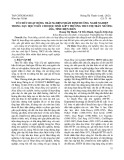Optimal Token Allocations in Solitaire Knock ’m Down
Arthur T. Benjamin Department of Mathematics Harvey Mudd College Claremont, CA 91711 benjamin@hmc.edu
Matthew T. Fluet Department of Computer Science Cornell University Ithaca, NY 14853 fluet@cs.cornell.edu
Mark L. Huber Department of Statistics Stanford University Stanford, CA 94305 mhuber@orie.cornell.edu
Submitted: February 28, 2000; Accepted: August 14, 2000
Abstract
In the game Knock ’m Down, tokens are placed in N bins. At each step of the game, a bin is chosen at random according to a (cid:12)xed probability distribution. If a token remains in that bin, it is removed. When all the tokens have been removed, the player is done. In the solitaire version of this game, the goal is to minimize the expected number of moves needed to remove all the tokens. Here we present necessary conditions on the number of tokens needed for each bin in an optimal solution, leading to an asymptotic solution. MR Subject Classi(cid:12)cations: primary: 91A60
1 Introduction
Knock ’m Down is a simple game to play that proves surprisingly di(cid:14)cult to analyze. At the beginning of the game, the player allocates t tokens to N bins. An allocation can be described by a vector X = (x1; x2; : : : ; xN ) of non-negative integers, with xi = t. At each step of the game, a bin is chosen at random, with the probability of choosing bin i (cid:12)xed at pi > 0. If at least one token remains in bin i when it is chosen, then one token is removed from the bin. The game continues until all of the tokens have been removed.
the electronic journal of combinatorics 8 (no. 2) (2001), #R2
1
P
2; : : : ; x(cid:3)
In Solitaire Knock ’m Down, the goal is to remove all the tokens in the shortest time possible. Given t tokens, N bins, and a (cid:12)xed probability vector P = (p1; p2; : : : ; pN ), we will say that an initial token allocation X (cid:3) = (x(cid:3) 1; x(cid:3) N ) is optimal if it minimizes the expected time needed to remove all of the tokens.
Intuitively, one would expect the optimal token placement to resemble the shape of the probability histogram, so that roughly tpi tokens are placed in bin i. However, recursive calculations in [3] reveal that even when one can allocate tokens exactly proportional to the probabilities, this allocation is seldom optimal. For example, when P = (1=3; 2=3) and t = 9, then X (cid:3) = (2; 7). When t = 1200 with the same P , X (cid:3) = (393; 807). When P = (:1; :2; :3; :4) and t = 10, then X (cid:3) = (0; 2; 3; 5). In the original version of Knock ’m Down, described in [1], t = 12 and P is the \dice total" vector 1 36(1; 2; 3; 4; 5; 6; 5; 4; 3; 2; 1). Here X (cid:3) = (0; 0; 1; 2; 2; 3; 2; 1; 1; 0; 0).
When N = 2 and P = (p; 1 − p), it is shown in [2] that with t tokens, the optimal allo- cation is X (cid:3) = (m; t − m), where m is the pth percentile of the Binomial(t; p) distribution. As a consequence, limt!1 X (cid:3)=t = P:
N > 2, and achieve the same asymptotic conclusion.
In this paper, we generalize these results to obtain necessary conditions for X (cid:3) when
2 The Token Adding Theorem and Consequences
Given a probability distribution P = (p1; : : : ; pN ) and token allocation X = (x1; : : : ; xN ), we de(cid:12)ne the random variable TX to be the number of rolls needed to clear allocation X. Consider arbitrary bins a and b, with pa < pb. Let Xa and Xb be the allocations obtained from X by adding one token to bins a and b respectively. Our (cid:12)rst theorem maintains that if xa=xb is at least pa=pb then Xa has a greater expected clearing time than Xb. More precisely,
Theorem 1. The Token Adding Theorem. Let X be a token allocation with t tokens such that pbxa (cid:21) paxb, where pa < pb. Then E[TXa] > E[TXb].
Proof. To clear allocation Xa, we must (cid:12)rst clear suballocation X and then clear the remaining token in bin a, if it has not already been removed. Thus TXa = TX + Ra, where Ra is the number of extra turns needed to clear the extra token in bin a. Ra is either 0 or a geometric random variable with mean 1=pa. De(cid:12)ning Rb analogously, we obtain (cid:19) (cid:18) (cid:19) (cid:18)
1 pb
− P r(Ra > 0) P r(Rb > 0) E[TX] + E[TX] + E[TXa] − E[TXb] =
=
1 pa P r(Ra > 0) − 1 pb
1 pa
P r(Rb > 0):
It remains to show that 1 pa
Notice that P r(Ra > 0) is the probability that suballocation X is cleared with bin a chosen exactly xa times. Thus, we de(cid:12)ne An;m to be the set of length n sequences of bin choices such that X is cleared on the nth turn with bin a selected exactly xa times and
the electronic journal of combinatorics 8 (no. 2) (2001), #R2
2
P r(Rb > 0). P r(Ra > 0) > 1 pb
(cid:11)2An;m
P
1X
n−tX
P r((cid:11)), where P r((cid:11)) is bin b selected xb + m times, where m (cid:21) 0. P r(An;m) = the product of the probabilities of the values in the sequence. Note that An;m may be empty for some values of t, n, and m. In particular, An;m = ; for n < t and for m > n − t. Therefore,
n=t
m=0
Similarly, let Bn;m be the set of length n sequences of bin choices such that X is cleared on the nth turn with bin b selected exactly xb times and bin a selected xa +m times. Thus,
1X
n−tX
P r(Ra > 0) = P r(An;m):
n=t
m=0
Hence to prove our theorem, it su(cid:14)ces to prove the following
1 pa
P r(An;m) (cid:21) 1 pb
P r(Rb > 0) = P r(Bn;m):
P r(At;0) > 1 pb
Lemma 1. Let X be a token allocation with t tokens and N values such that pbxa (cid:21) paxb, where pa < pb. Then for n (cid:21) t > 0 and 0 (cid:20) m (cid:20) n − t, P r(Bn;m). Further, the inequality is strict in the case n = t and m = 0.
1 pa P r(An;0) = P r(Bn;0) = 0.
n), where p0
1; : : : ; p0
a = p0
b = 0, and p0
We begin with the case n = t and m = 0. Recalling the de(cid:12)nitions of An;m and Bn;m, we note that both At;0 and Bt;0 are the set of sequences of values of length n such that X is cleared on the tth turn with exactly xa a’s and xb b’s. Hence At;0 = Bt;0. Further, since n = t, neither At;0 nor Bt;0 is empty. Since, pa < pb, then 1 P r(Bt;0). pa Next, consider the case n > t and m = 0. Again, we note that An;0 = Bn;0. Thus, P r(At;0) (cid:21) 1 P r(Bt;0). The inequality is strict except when N = 2 and m > t, where pb
Finally, consider the case n > t and 0 < m (cid:20) n − t. Let X 0 be the allocation of t − xa − xb tokens with all xa + xb tokens removed from bins a and b in allocation X. Let T 0 be the number of turns needed to clear X 0 using probability vector P 0 = (p0 i = pi=(1 − pa − pb) for i 6= a; b. In other words, T 0 is the number of non-a and non-b turns needed to clear X 0. We may write P r(An;m) as the sum of two probabilities:
where A1 is the event that X is cleared on the nth turn with exactly xa a’s and xb + m b’s and the nth token removed is from bin a. A2 is the event that X is cleared on the nth turn with exactly xa a’s and xb + m b’s and the nth token removed is not in bin a nor bin b. Note that since m > 0, the nth token removed can not be from bin b. Likewise, we may write P r(Bn;m) as the sum of two probabilities:
P r(An;m) = P r(A1) + P r(A2);
where B1 is the event that X is cleared on the nth turn with exactly xa + m a’s and xb b’s and the nth token removed is from bin b. B2 is the event that X is cleared on the nth
the electronic journal of combinatorics 8 (no. 2) (2001), #R2
3
P r(Bn;m) = P r(B1) + P r(B2);
turn with exactly xa + m a’s and xb b’s and the nth token removed is neither in bin a nor bin b. Since m > 0, the nth token removed can not be from bin a.
P r(B1) P r(Bn;m), we show that 1 pa P r(An;m) (cid:21) 1 pb P r(A1) (cid:21) 1 pb
In order to show that 1 pa P r(B2). P r(A1) (cid:21) 1 pb
P r(B1). The inequality is obviously true when P r(B1) = P r(A2) (cid:21) 1 and 1 pb pa First, we show 1 pa
0, (e.g., when xb = 0). Now when P r(B1) 6= 0, (cid:18)
(cid:19)(cid:18) (cid:19)
a pxb+m pxa
b
P r(A1) = P r(T 0 (cid:20) n − xa − xb − m:) (cid:19)(cid:18) (cid:19) (cid:18)
a
Then,
P r(B1) = P r(T 0 (cid:20) n − xa − xb − m:) pxb b pxa+m n − 1 xa − 1 n − 1 xb − 1 n − xa xb + m n − xb xa + m
(cid:0)
(cid:1)(cid:0)
(cid:0) (cid:1)(cid:0)
a pxb+m pxa b pxb b pxa+m a
1 pa 1 pb
1 pa 1 pb
n−1 xa−1 n−1 xb−1
= P r(A1) P r(B1)
(cid:19)m+1
= P r(T 0 (cid:20) n − xa − xb − m) P r(T 0 (cid:20) n − xa − xb − m) pm+1 b pm+1 a (cid:1) n−xa xb+m (cid:1) n−xb xa+m (n−1)! (xa−1)!(xb+m)!(n−xa−xb−m)! (n−1)! (xb−1)!(xa+m)!(n−xa−xb−m)! (cid:18)
(cid:18)
=
pb pa pb pa mY
= (xb − 1)!(xa + m)! (xa − 1)!(xb + m)! (cid:19)m+1 xa(xa + 1) (cid:1) (cid:1) (cid:1) (xa + m) xb(xb + 1) (cid:1) (cid:1) (cid:1) (xb + m)
pb(xa + k) pa(xb + k)
k=0 (cid:21) 1:
=
pb(xa + k) − pa(xb + k) = pbxa − paxb + k(pb − pa) (cid:21) 0:
the electronic journal of combinatorics 8 (no. 2) (2001), #R2
4
The last step follows from our theorem’s initial assumptions, since
By a similar calculation, when P r(B2) 6= 0,
(cid:0) (cid:1)(cid:0)
=
a pxb+m pxa b pxb b pxa+m a
1 pa 1 pb
1 pa 1 pb
n−1 xa n−1 xb
=
(cid:0) (cid:1)(cid:0) P r(A2) P r(B2) P r(T 0 = n − xa − xb − m) P r(T 0 = n − xa − xb − m)
=
pm+1 b pm+1 a (cid:1) n−xa−1 xb+m (cid:1) n−xb−1 xa+m (n−1)! xa!(xb+m)!(n−1−xa−xb−m)! (n−1)! xb!(xa+m)!(n−1−xa−xb−m)! (cid:18)
=
(cid:18)
=
(cid:19)m+1 xb!(xa + m)! xa!(xb + m)! (cid:19)m+1 (xa + 1)(xa + 2) (cid:1) (cid:1) (cid:1) (xa + m) (xb + 1)(xb + 2) (cid:1) (cid:1) (cid:1) (xb + m) pb pa pb pa mY
k=1
(cid:21) 1;
pb pa pb(xa + k) pa(xb + k)
as desired. The lemma and theorem are now established.
1; : : : ; x(cid:3)
N ) be an optimal allocation of t tokens with probability
The Token Adding Theorem leads to practical necessary conditions for optimal token allocation. The (cid:12)rst corollary establishes a relationship between the ratio of tokens in any two bins and their ratio of probabilities. Speci(cid:12)cally,
a − 1) < pax(cid:3) b:
a − 1) (cid:21) pax(cid:3)
a−1; : : : ; x(cid:3)
1; : : : ; x(cid:3)
Corollary 1. Let X (cid:3) = (x(cid:3) vector P = (p1; : : : ; pn). If pa < pb, then pb(x(cid:3)
b. Then by applying the Token Adding Theorem to the N ), we see that X (cid:3) can not be optimal since a−1; : : : ; x(cid:3)
1; : : : ; x(cid:3)
N ).
b +1; : : : ; x(cid:3)
Proof. Suppose pb(x(cid:3) t−1-token allocation X = (x(cid:3) it has a higher average clearing time than allocation (x(cid:3)
1; : : : ; x(cid:3)
N ) be an optimal allocation of t tokens with probability
As an immediate corollary, we have the following intuitive result.
a (cid:20) x(cid:3) b:
By modifying the proof of the Token Adding Theorem, one can also obtain, as done
in [3], the following two corollaries.
1; : : : ; x(cid:3)
N ) be an optimal allocation of t tokens with probability
Corollary 3. Let X (cid:3) = (x(cid:3) vector P = (p1; : : : ; pn). If pa = pb, then jx(cid:3)
a − x(cid:3)
bj (cid:20) 1:
Corollary 4. If the bins are arranged so that P satis(cid:12)es p1 (cid:21) p2 (cid:21) (cid:1) (cid:1) (cid:1) (cid:21) pN , then there exists an optimal allocation X (cid:3) such that x(cid:3)
2 (cid:21) (cid:1) (cid:1) (cid:1) (cid:21) x(cid:3) N .
1 (cid:21) x(cid:3)
The four previous corollaries can be used to drastically cut down the number of can- didates for optimal allocation. For instance, in the original game of Knock ’m Down with t = 12 tokens, the candidates for optimal allocation are reduced from 646; 646 to 49.
the electronic journal of combinatorics 8 (no. 2) (2001), #R2
5
Corollary 2. Let X (cid:3) = (x(cid:3) vector P = (p1; : : : ; pn). If pa < pb, then x(cid:3)
However, some allocations, such as putting all tokens in the most probable bin, are not eliminated by the previous corollaries. In the next section, we obtain lower bounds for the optimal number of tokens in each bin, resulting in a natural allocation of tokens in the long run.
3 Lower Bounds
As in the previous section, given a con(cid:12)guration X = (x1; : : : ; xN ) where xi = t, we let TX denote the (cid:12)rst time that all of the tokens have been removed. Then an optimal solution X (cid:3) will satisfy E[TX(cid:3)] (cid:20) E[TX] for all con(cid:12)gurations X.
1; : : : ; x(cid:3)
N ) be an optimal allocation of t > 0 tokens, with proba- i is at least as big as the
Theorem 2. Let X (cid:3) = (x(cid:3) bility vector P = (p1; : : : ; pN ). Then for N (cid:21) 2, in each bin i, x(cid:3) pi=(N − 1) percentile of the Binomial distribution with parameters t and pi.
P
:
P r((cid:28)i > TX(cid:3)) >
pi N − 1
Proof. When N = 2, this is proved in [2]. For N > 2, we shall prove something slightly stronger. The idea behind our proof is that in an optimal con(cid:12)guration, the probability of choosing from bin i more than x(cid:3) i times before the end of the game should be small. For each bin i, let (cid:28)i be the (cid:12)rst time that bin i is chosen x(cid:3) i + 1 times. If bin i has been chosen more than x(cid:3) i times by the end of the game, then (cid:28)i < TX(cid:3). Otherwise, when bin i is chosen exactly x(cid:3) i times at the end of the game, we set (cid:28)i = 1. Note that (cid:28)i cannot equal TX(cid:3) since the game cannot end on a \wasted" turn. Summarizing, (cid:28)i > TX(cid:3) if and only if bin i is chosen exactly x(cid:3) i times at the end of the game. Our theorem is based on the following lemma. Lemma 2. For N > 2, let X (cid:3) be an optimal allocation of t tokens. Then for each bin i,
i = xi + 1, x0
j − 1 and x0
Proof. We shall show the contrapositive. Let X be a con(cid:12)guration with P r((cid:28)i > TX) (cid:20) pi=(N − 1). We shall construct a new con(cid:12)guration X 0 with E[TX0] < E[TX].
Since (cid:28)i 6= TX, we have,
Let Ej be the event that a token in bin j was the last one removed in the game. Consider the event (cid:28)i < TX. When this occurs, all of the tokens in bin i are gone before time (cid:28)i, but at least one token remains in some other bin. In particular, there exists at least one bin j with P r(Ejj(cid:28)i < TX) (cid:21) 1=(N − 1) and xj (cid:21) 1. Construct the new j = x0 con(cid:12)guration X 0 by setting x0 k = xk for k di(cid:11)erent from i and j. In other words, X 0 is created from X by transferring a token from bin j to bin i.
and
E[TX0] = E[TX0j(cid:28)i < TX]P r((cid:28)i < TX) + E[TX0j(cid:28)i > TX]P r((cid:28)i > TX):
Now we show how these expectations relate to one another.
the electronic journal of combinatorics 8 (no. 2) (2001), #R2
6
E[TX] = E[TXj(cid:28)i < TX]P r((cid:28)i < TX) + E[TXj(cid:28)i > TX]P r((cid:28)i > TX);
Suppose that (cid:28)i > TX. Then when all of the tokens of X have been removed, one token still remains in bin i under con(cid:12)guration X 0. The expected number of additional steps needed to remove this (cid:12)nal token is 1=pi. Therefore,
1 pi
Suppose that (cid:28)i < TX. Then we have chosen bin i at least xi + 1 = x0
i times, and so no tokens remain in this bin. If any bin other than bin j has the last token under X, then this will also be the last token under X 0 as well, and TX = TX0. On the other hand, if j is the last token remaining under X, at this point there are no tokens left under X 0, so TX0 < TX. The expected time to remove this (cid:12)nal token from bin j is 1=pj, so altogether
: E[TX0j(cid:28)i > TX] = E[TXj(cid:28)i > TX] +
E[TX0j(cid:28)i < TX] = E[TX0j(cid:28)i < TX; Ej]P r(Ejj(cid:28)i < TX)
=
(cid:19)
+ E[TX0j(cid:28)i < TX; (cid:22)Ej]P r( (cid:22)Ejj(cid:28)i < TX) (cid:18) E[TXj(cid:28)i < TX; Ej] − 1 pj
P r(Ejj(cid:28)i < TX)
P r(Ejj(cid:28)i < TX)
+ E[TXj(cid:28)i < TX; (cid:22)Ej]P r( (cid:22)Ejj(cid:28)i < TX)
(cid:20) E[TXj(cid:28)i < TX] −
:
< E[TXj(cid:28)i < TX] −
= E[TXj(cid:28)i < TX] − 1 pj
(cid:18)
1 (N − 1)pj 1 (N − 1)(1 − pi)
E[TX0] <
P r((cid:28)i > TX)
Putting it all together, we have that (cid:19)
E[TXj(cid:28)i > TX] + (cid:18)
(cid:19)
1 pi
E[TXj(cid:28)i < TX] −
P r((cid:28)i < TX) (cid:19)
−
:
+
= E[TX] + P r((cid:28)i > TX) + 1 pi 1 (N − 1)(1 − pi) (cid:18) 1 (N − 1)(1 − pi) 1 (N − 1)(1 − pi)
Therefore, since P r((cid:28)i > TX) (cid:20) pi N −1
;
+
1 (N − 1)(1 − pi)
=
1 N − 1 (N − 1)(1 − pi) + pi − (N − 1) (N − 1)2(1 − pi)
=
− E[TX0] − E[TX] < pi (N − 1)2(1 − pi)
< 0:
Thus, E[TX0] < E[TX], and X is not an optimal solution, establishing our lemma.
the electronic journal of combinatorics 8 (no. 2) (2001), #R2
7
pi(2 − N) (N − 1)2(1 − pi)
To complete the proof of Theorem 2, suppose that x(cid:3)
i was less than the pi=(N − 1)
percentile of the Binomial distribution with parameters t and pi. Then since TX(cid:3) (cid:21) t,
i times among the (cid:12)rst t turns)
= P r(Bin i is chosen at most x(cid:3) < pi=(N − 1);
contradicting our lemma.
Because pi=(N − 1) is a constant, and the binomial distribution concentrates near tpi
for large t, we have as an immediate corollary,
1; : : : ; x(cid:3)
N ) be an optimal allocation of t tokens with probability
Corollary 5. Let X (cid:3) = (x(cid:3) vector P = (p1; : : : ; pn). Then limt!1 X (cid:3)=t = P:
P r((cid:28)i > TX(cid:3)) (cid:20) P r((cid:28)i > t)
4 Acknowledgment
We thank Professor Janet Myhre and The Reed Institute for Applied Mathematics for support of this research.
References
[1] A.T. Benjamin and M.T. Fluet, The Best Way to Knock ’m Down, The UMAP Journal, vol 20.1, 11{20, 1999.
[2] A.T. Benjamin and M.T. Fluet, What’s Best?, The American Mathematical Monthly, vol 107, No. 6, 560{562, 2000.
the electronic journal of combinatorics 8 (no. 2) (2001), #R2
8
[3] M.T. Fluet, Searching for Optimal Strategies in Knock ’m Down, senior thesis, Harvey Mudd College, Claremont, CA, 1999.



































